This easy galette dough guide is perfect for beginner bakers because galette crust is like a rustic, more-forgiving pie crust. You can use this recipe for sweet and savory galettes.

While I'm most well-known for my oil pie crust, my favorite pastry to bake is a galette. Galette is a French butter-based, rustic pastry dough that is made with either sweet and savory fillings.
My two favorite galettes are this sweet berry galette and this savory cherry tomato galette.
Galette dough requires just 4 ingredients and looks rustic on purpose, making it a great option for beginner bakers.
In this guide, I'll walk you through the foolproof method and tips I have to ensure that your galette dough comes out perfectly every time.
Jump to:
Ingredients

- Flour: I use all-purpose flour to make galette dough because it is practical. Some more traditional versions of galette contain almonds or other nuts, but this home-baker-approved galette dough simply uses all-purpose flour.
- Butter: Choose unsalted butter. If you only have salted butter on hand, simply decrease the added table salt to ¼ teaspoon.
- Salt: I recommend table salt.
- Ice water: Ice water is quite literally a combination of ice cubes and water. This creates the coldest water possible to keep the butter from melting.
- Sugar: Granulated sugar is used in sweet galette crusts. For savory galette crusts, I omit the sugar.
Recommended equipment
Good news, galette dough can be made with just a bowl, a fork, and a sheet pan. But if you plan to make galettes or other pastries frequently, there are a few ways to make it easier:
- Pastry cutter: This is used to cut butter into flour. I also use this tool to make biscuits. If you don't have a pastry cutter, you can use your fingers or a fork.
- Silicon baking mat: This provides a non-stick surface that makes rolling out the dough and cleaning up much easier. You can also roll out dough on a clean countertop or between two sheets of wax paper.
- Rolling pin: This is essential for rolling the dough out to a uniform thickness. If you don't have a rolling pin, a drinking glass or wine bottle with the label removed will work.
How to make galette dough
By hand

In a large bowl, combine the flour, salt, and sugar (if using). Cut the cold butter into small cubes and add them to the bowl.
Using a pastry cutter or your fingers, work the butter into the flour until the mixture resembles coarse crumbs. The butter pieces should be no larger than a pea.
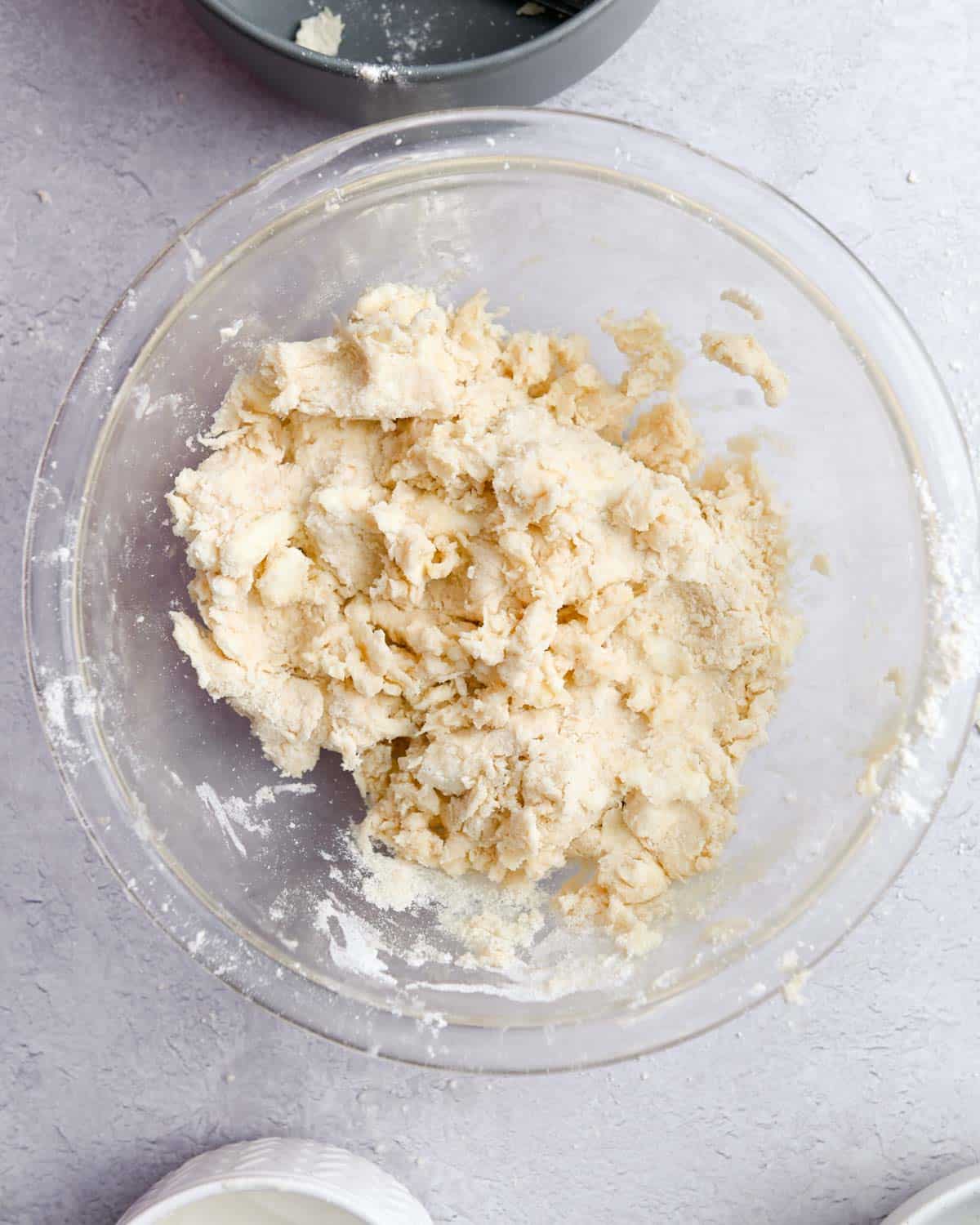
Gradually add ice water, one tablespoon at a time, and mix until the dough comes together. The dough should still be a little bit crumbly but otherwise holding together.
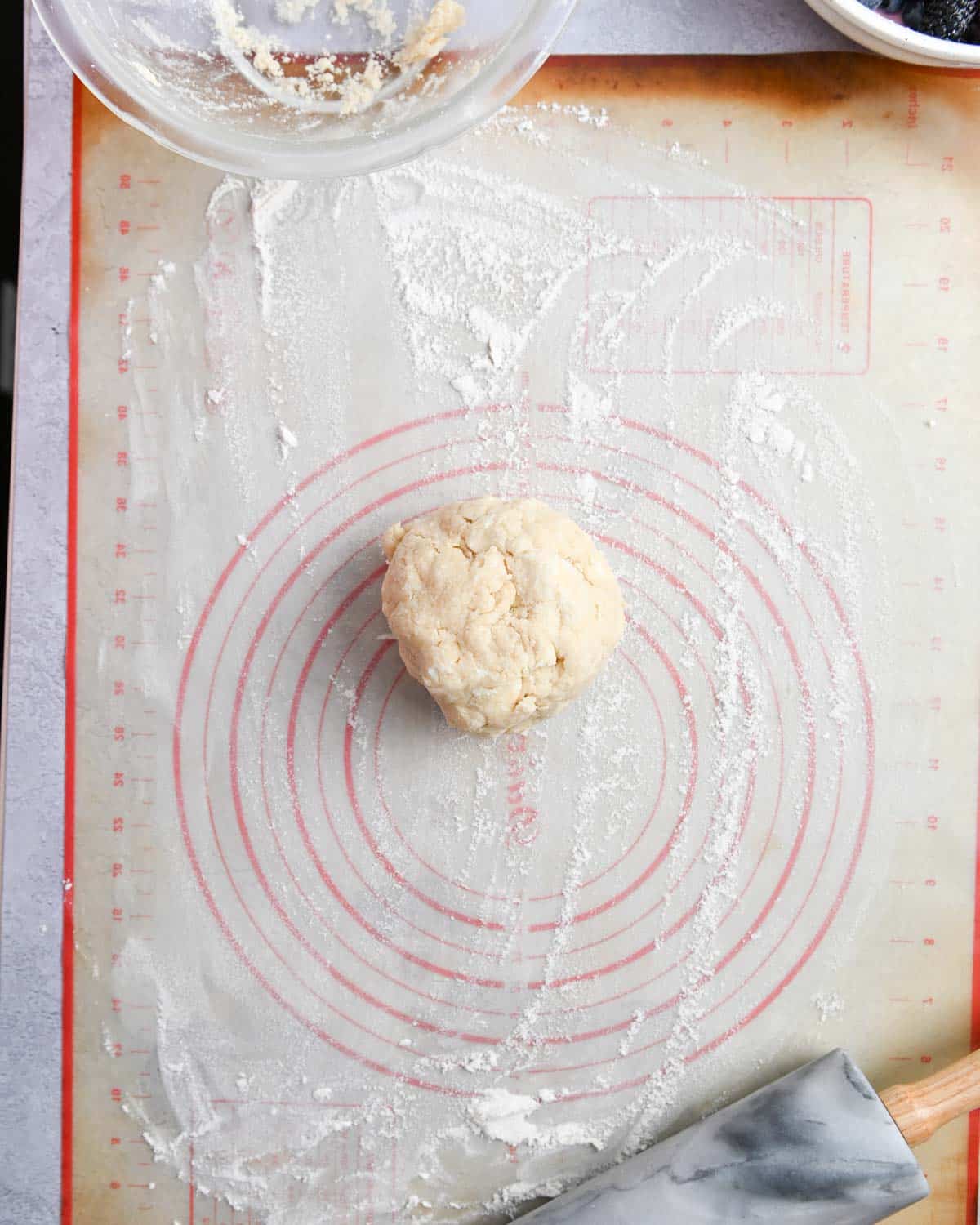
Gather the galette dough into a ball and wrap it tightly in plastic wrap. Chill in the refrigerator for at least 30 minutes before using.

Remove the dough from the plastic wrap and roll it out into a 12 by 12-inch circle. It's okay if the circle isn't perfectly round. In fact, my galette dough usually appears quite rustic and I like it that way.
For a perfect circle, simply use a pizza cutter to cut off any uneven edges.
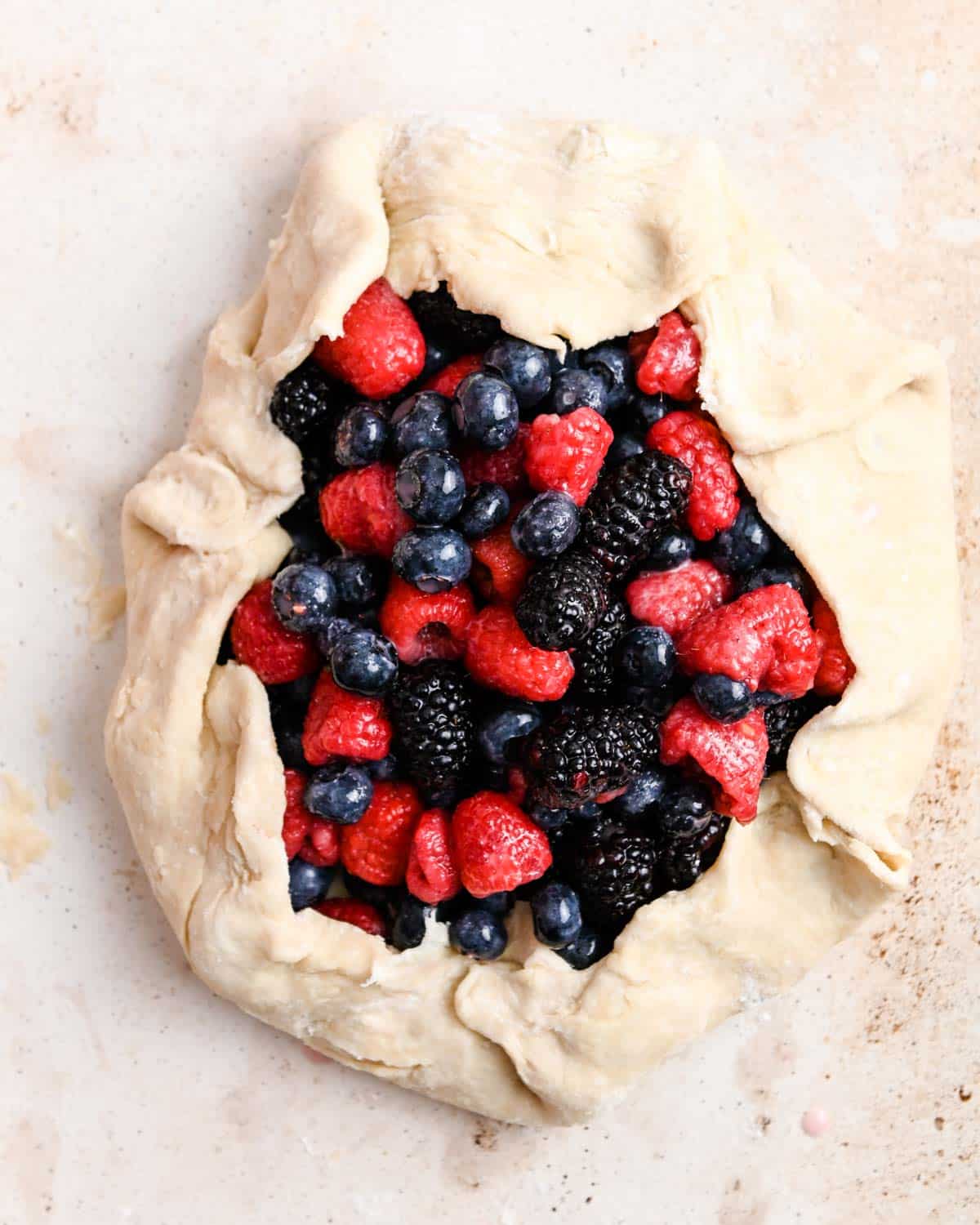
Fill the center of the dough with a sweet or savory filling, leaving at least two inches around the edge. Fold the galette dough in over just the edge of the filling, pinching the crust between your fingers to form a seal.
Forming a seal is important because it keeps the filling from leaking out during the baking process.
In a food processor
This is the easiest way to make galette crust because the food processor does most of the mixing for you.
In a food processor, combine the flour, salt, and sugar (if using). Add the cubed butter and pulse until the mixture resembles coarse crumbs.
Gradually add ice water, one tablespoon at a time, and pulse just until the dough comes together. The dough should be holding together but still a little bit crumbly. Be careful not to overmix.
Gather the dough into a ball and wrap it tightly in plastic wrap, as above with the by-hand method.
Tips for success
- If you don't have a pastry cutter, I recommend slicing butter into pea-sized pieces before cutting it into flour.
- Use cold ingredients: Just like with vegan biscuits, galette dough turns out best when all ingredients are chilled. I recommend cubing the butter and placing it in the freezer along with your mixing bowl for just 10 minutes before preparing the galette crust.
- Chill the dough: This allows the gluten to relax and fully absorb the water, resulting in a more tender dough. If chilling for longer than 30 minutes, make sure that the dough is very tightly wrapped in plastic wrap or it may dry out in the fridge.
- Handle the dough gently: Overworking the dough can result in a tough crust. Stir the dough until it is just holding together. It is okay if it is still a little crumbly.
- Rolling out the dough: Use either a clean countertop or a silicon baking mat to roll out the dough. Sprinkle with a fine layer of flour or cornmeal to keep the dough from sticking. Roll from the center outward, rotating the dough in a clockwise fashion after each roll.
- Use parchment paper or a baking mat: I like to bake galettes on a pre-heated pizza stone or parchment paper for easy clean-up, but it isn't required. Just like with pizza dough, you can bake it directly on a pan.
Variations and ingredient swaps
- Gluten-free galette dough: Substitute the regular flour with your preferred all-purpose gluten-free flour blend, such as Bob's Red Mill or King Arthur 1:1 flour. Adjust the amount of liquid as needed to achieve the right consistency.
- Whole wheat flour: Replace a portion or all of the regular flour with whole wheat flour for a nuttier flavor and heartier texture. Whole wheat flour produces a denser galette that is more prone to crumbling.
- Vegan galette dough: Instead of butter, use any plant or vegan butter sticks. I recommend Country Crock or Miyoko's. Make sure the fat is cold and solid for best results. I have not tested galette dough using coconut oil, so I cannot confirm if it works.
- Sugar: For sweet galettes, I recommend using 1 tablespoon of granulated sugar. For savory galettes, I do not use sugar in the dough.
- Cornmeal: For savory galettes, I love to roll out the dough on cornmeal. This adds extra texture and helps with browning, especially if you don't use an egg wash.
- Egg wash: This is optional, but adding an egg wash helps the galette crust to brown and become crisper.
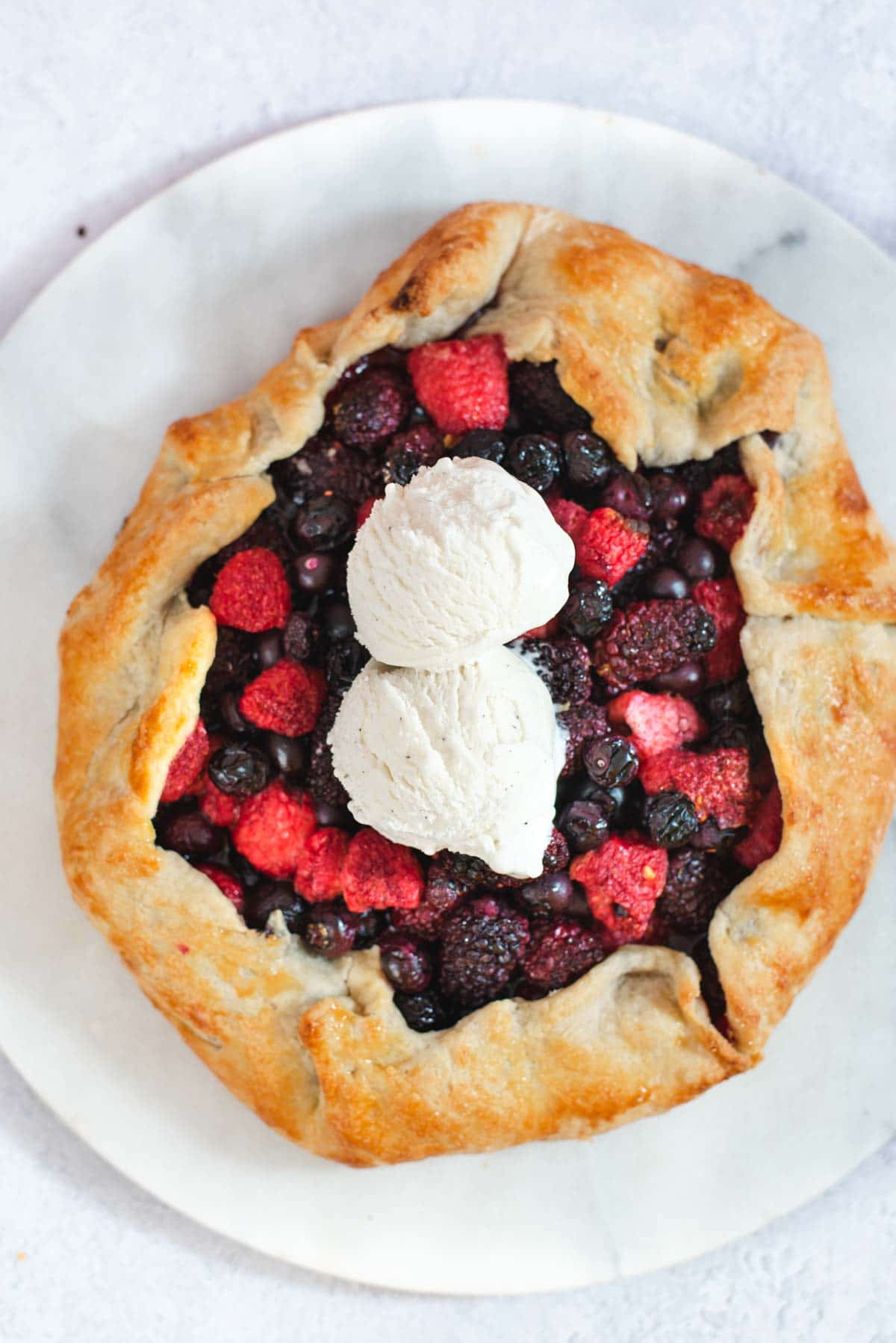
FAQ
Galette crust becomes soggy when the filling is too wet or when the butter in the pastry melts too quickly. To avoid a soggy galette crust, keep all ingredients cold and work quickly, especially if working in a hot kitchen.
Another option is to sprinkle a layer of cornmeal on the baking sheet or parchment paper. This absorbs excess moisture and creates a crisper texture.
Galette dough can be prepared ahead of time and refrigerated for up to 2 days before using. Ensure it is tightly wrapped in plastic wrap to prevent drying. When ready to use the dough, you may need to add an extra sprinkle of flour if it dried out in the fridge.
Short answer: Yes, you can use this galette recipe for a pie crust! Longer answer: While some versions of galette dough, especially more traditional French ones, contain ground nuts, this galette recipe is pretty much the exact same thing as a pie crust. The main difference is in the baking technique.
More baking favorites
Did you try this recipe? You can leave a star rating in the recipe card or a review in the comments below. Or check out my new cookbook and keep up to date with my YouTube, Instagram, TikTok, or newsletter!
📖 Recipe
Want to Save This Recipe?
Enter your email & I'll send it to your inbox. Plus, get great new recipes from me every week!
By submitting this form, you consent to receive emails from Cozy Peach Kitchen

How to Make Galette Dough
Equipment
- pastry cutter optional
- baking mat optional
Ingredients
- 1 and ½ cups all-purpose flour
- 1 tablespoon granulated sugar (optional, see note 1)
- ½ teaspoon table salt
- ½ cup unsalted butter cubed
- 5 to 7 tablespoons ice water see note 2
- 1 egg yolk optional
- 1 tablespoon milk or water
Instructions
- In a medium bowl, stir together the flour, salt, and optional sugar (use sugar for sweet galettes and omit for savory galettes). Using a pastry cutter or your fingers, cut in the cubes of butter until they are crumbly and pea sized.
- Mix in the ice cold water one tablespoon at a time, stirring with a spoon until a cohesive ball of dough forms. It is ready when the dough can hold together on its own but it will still have some crumbly pieces.
- Wrap the dough in plastic wrap or foil and let rest in the fridge for 30 minutes. This allows the dough to hydrate and the butter to chill.
- Remove the dough from the fridge. On a baking mat or lightly floured surface, roll out the dough until it is roughly 12x12 inches. It does not need to be a perfect circle.
- Transfer the dough to a parchment paper lined baking sheet (parchment paper is optional but makes cleanup easier). Place the filling in the center, leaving two inches of dough uncovered around the outside.
- Fold the dough in over just the edge of the filling, pinching overlapping edges together as needed. This keeps the filling from spilling out during baking.
- Optional egg wash: Make an egg wash by whisking together one egg yolk with 1 tablespoon milk (water works in a pinch). Brush it on the edges of the galette crust before baking. This results in a more golden and crispy crust.
- Bake at 425F for 25-30 minutes, until the crust is golden and the filling is bubbling. Let the galette cool on a cooling rack for at least an hour before slicing.
Video
Notes
- Sugar: Use sugar if making a sweet filling, such as a fruit galette. Omit the sugar for savory galettes, such as tomato or vegetable filling.
- Ice water: Add ice to a liquid measuring cup and top with water to make very cold water. Measure tablespoons of water from this ice water container.
- Use cold ingredients: Just like with biscuits, galette dough turns out best when all ingredients are chilled. I recommend cubing the butter and placing it in the freezer along with your mixing bowl for just 10 minutes before preparing the galette crust.
- This galette dough works with both sweet and savory fillings. If needed, you can adjust galette cook time and temperature based on the recipe used for the filling.


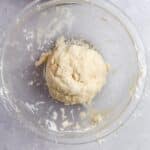

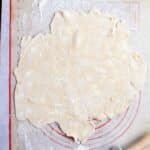


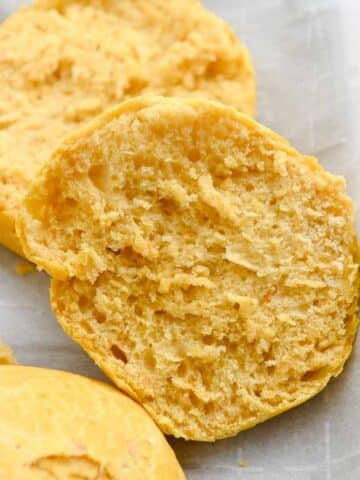
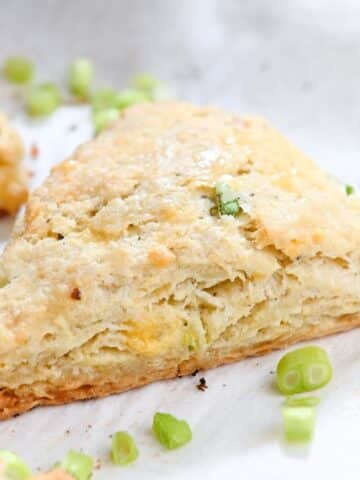

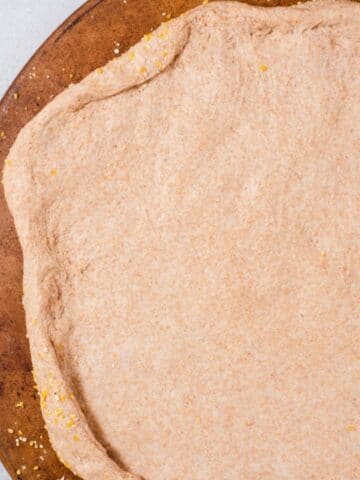
Comments
No Comments